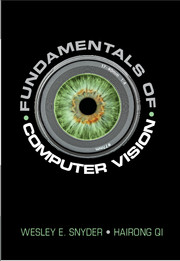Book contents
- Frontmatter
- Dedication
- Contents
- Preface
- For the Instructor
- Part I Preliminaries
- 1 Computer Vision, Some Definitions, and Some History
- 2 Writing Programs to Process Images
- 3 Review of Mathematical Principles
- 4 Images: Representation and Creation
- Part II Preprocessing
- Part III Image Understanding
- Part IV The 2D Image in a 3D World
- A Support Vector Machines
- B How to Differentiate a Function Containing a Kernel Operator
- C The Image File System (IFS) Software
- Author Index
- Subject Index
- References
4 - Images: Representation and Creation
from Part I - Preliminaries
Published online by Cambridge University Press: 25 October 2017
- Frontmatter
- Dedication
- Contents
- Preface
- For the Instructor
- Part I Preliminaries
- 1 Computer Vision, Some Definitions, and Some History
- 2 Writing Programs to Process Images
- 3 Review of Mathematical Principles
- 4 Images: Representation and Creation
- Part II Preprocessing
- Part III Image Understanding
- Part IV The 2D Image in a 3D World
- A Support Vector Machines
- B How to Differentiate a Function Containing a Kernel Operator
- C The Image File System (IFS) Software
- Author Index
- Subject Index
- References
Summary
Computers are useless. They can only give us answers.
– Pablo PicassoIntroduction
Since you have already had a course in image processing, it should not be necessary to describe how images are formed. Representations, however, are another matter. This chapter discusses various image representation schemes as well as a way of treating images as surfaces.
• (Section 4.2) In this section, we discuss mathematical representations both for the information contained in an image and for the ways in which images are stored and manipulated in a digital machine.
• (Section 4.3) In this section, we introduce a way of thinking about images – as surfaces with varying height – which we will find to be a powerful way to describe both the properties of images as well as operations on those images.
Image Representations
In this section, several ways to represent the information in an image are discussed. These representations include: iconic, functional, linear, probabilistic, and graphical representations. Note that in a digital image, the first dimension is columns and the second is rows. In a 3D digital image, the dimensions are columns, rows, and frames.
Iconic Representations (An Image)
An iconic representation of the information in an image is an image. Yeah, right; and a rose is a rose is a rose. When you see what we mean by functional, linear, and relational representations, you will realize we need a word for a representation that is itself a picture. In the following, we briefly describe 2D, 3D, and range images.
• 2D images: The familiar 2D image is the brightness image, also called luminance image. These include photographs; the things you are used to calling “images” or “pictures.” These might be color or grayscale. (Be careful with the words “black and white,” as that might be interpreted as “binary”). A shadow is a 2D binary image. We usually denote the brightness at a point < x, y > as f (x, y). Note: x and y could be either real numbers or integers. In the integer case, we are referring to discrete points in a sampled image. These points are called “pixels,” short for “picture elements.” In the case of real numbers we are usually thinking of the image as a function.
- Type
- Chapter
- Information
- Fundamentals of Computer Vision , pp. 39 - 48Publisher: Cambridge University PressPrint publication year: 2017



